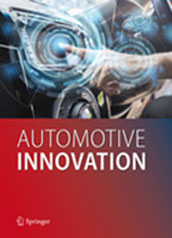

|
The journal Automotive Innovation is sponsored by China SAE, published through Springer, distributed around the world, and reflects the top-level research and technical advance of automotive engineering. Automotive Innovation newsletter in July includes the following contents: 1. A Glimpse of Experts——Prof. Junying Min from Tongji University 2. Article Recommendation——Four papers on technologies of safety, autonomous driving and lightweight 3. China SAE News: · Automotive Innovation Special Issue for “Automotive Lightweight” is calling for papers |

 Prof. Junying Min Professor of Tongji University, Alexander von Humboldt Research Fellow, CIRP Research Affiliate, Vice Chairman of Automotive Body Tool and Equipment Committee of China Die & Mould Industry Association |
Research Interests Heat-assisted forming processes of lightweight materials, advanced joining processes of dissimilar materials, applied mechanics of lightweight materials, etc. |
||
|
Achievements Junying Min completed his doctorate in December, 2012 at Tongji University. He was a postdoc successively at the University of Hawaii and University of Michigan from 2013 to 2014, and also a visiting scientist at the General Motors Global R&D Center. He received the Hiwin Doctoral Dissertation Award in 2014. He was granted the Alexander von Humboldt Postdoctoral Research Fellowship in 2014 and conducted research at the Ruhr-University Bochum from 2015 to 2017. In 2017, he joined the School of Mechanical Engineering, Tongji University as a full professor. To-date he has published more than 50 SCI-papers (including 25 JCR Q1 papers) and delivered over 30 talks on international conferences. He applied 1 US patent and 5 China patents. His research particularly on hot stamping of boron steels, accurate characterization of mechanical behavior of sheet metals, friction stir blind riveting/friction drilling riveting etc. has contributed to the application of lightweight materials e.g. advanced high strength steels and Al alloys on automotive bodies. |
|||
|
Perspective: challenges and development trends for lightweight technology Automotive lightweight is an eternal theme in the automotive industry. It saves energy and reduces emissions, and improves vehicle safety and handling performance as well. “Apply the right material at the right place”, “Design the right property at the right place”, and “Select the right joining process at the right place”, require us to systematically conduct innovative research from the perspectives of new design, new material, new process and cost. |
|||

   
|
Experimental and Numerical Study of Cervical Muscle Contraction in Frontal Impact Zhenhai Gao, Zhao Li, Hongyu Hu, Fei Gao |
||
| In a crash situation, drivers typically make evasive maneuvers before an upcoming impact, which can affect the kinematics and injury during impact. The purpose of the current study was to investigate the response and effect of drivers’ cervical muscles in a frontal impact. A crash scenario was developed using a vehicle driving simulator, and 10 volunteers were employed to drive the simulator at 20 km/h, 50 km/h, 80 km/h and 100 km/h. Electromyography (EMG) was recorded from the sternocleidomastoideus (SCM), splenius cervicis (SPL) and trapezium (TRP) muscles using a data acquisition system, and the level of muscle activation was calculated. A numerical study was conducted using data collected in the experiment. The results revealed that the cervical muscles were activated during drivers’ protective action. EMG activity of cervical muscles was greater than during normal driving. EMG activity increased with driving speed, with the SCM and TRP exhibiting larger increases than the SPL. The kinematics and load of the driver were influenced by muscle activation. Before the collision, the head of an active model stretched backward, while the passive model kept the head upright. In low-speed impact, the torque and shear of the cervical muscle in the active model were much lower than those in the passive model, while the tension of the cervical muscle was higher in the active model compared with the passive model. The results indicated that the incidence of cervical injury in high speed impact is complex. | |||
|
Keywords: Cervical injury · Frontal impact · Active muscle force · Driving simulator Gao, Z., Li, Z., Hu, H. et al. Experimental and numerical study of cervical muscle contraction in frontal impact. Automotive Innovation 2(2): 93-101(2019) |
|||
| Full Paper Reading>> | |||
   
|
Concept Study of a Self-localization System for Snow-covered Roads Using a Four-layer Laser Scanner Tetsushi Mimuro, Naoya Taniguchi, Hiroyuki Takanashi |
||
| Many advanced driver assistance systems have entered the market, and automated driving technologies have been developed. Many of them may not work in adverse weather conditions. A forward-looking camera, for example, is the most popular system used for lane detection but does not work for a snow-covered road. The present paper proposes a self-localization system for snowy roads when the roadsides are covered with snow. The system employs a four-layer laser scanner and onboard sensors and uses only pre-existing roadside snow poles provided for drivers in a snowy region without any other road infrastructure. Because the landscape greatly changes in a short time during a snowstorm and snow removal works, it is necessary to restrict the landmarks used for self-localization to tall objects, like snow poles. A system incorporating this technology will support a driver’s eff orts to keep to a lane even in a heavy snowstorm. | |||
|
Keywords: Advanced driver assistance systems · Adverse weather · Laser scanner · Self-localization system Mimuro, T., Taniguchi, N., Takanashi, H.: Concept study of a self-localization system for snow-covered roads using a four-layer laser scanner. Automotive Innovation 2(2), 110-120(2019) |
|||
| Full Paper Reading>> | |||
   
|
Effect of Atmospheric Pressure Plasma Treatment on the Lap-Shear Strength of Adhesive-Bonded Sheet Molding Compound Joints Shuang Wang, Junying Min, Jianping Lin, Chengcheng Sun, Shanglu Yang |
||
| Atmospheric pressure plasma treatment (APPT) technology was used herein to treat sheet molding compound (SMC) substrates to increase the lap-shear strength of adhesive-bonded SMC joints. Further, the mechanisms behind the lap-shear strength improvements in APPT-treated adhesive-bonded SMC joints were explored. A maximum lap-shear strength about three times that of the as-received SMC joints was achieved when the APPT distance was set to 20 mm. The surface roughness, which exhibited little benefit to the lap-shear strength, was determined to not be the primary reason for the increase in lap-shear strength. Specifically, X-ray photoelectron spectra revealed that an increased amount of O-containing groups (i.e., C–O–H, C–O–C, H–O–C=O or R–O–C=O) following APPT contributed to the improved lap-shear strength. In addition, the surface free energy increased significantly after APPT, which improved the lap-shear strength of the adhesive-bonded SMC joints. Compared to the change of surface morphology, the changes in both the surface chemical property and surface free energy played larger roles in increasing the lap-shear strength of APPT-treated SMC joints. | |||
|
Keywords: Plasma treatment · SMC · Lap-shear strength · Chemical properties · Surface free energies Wang, S., Min, J., Lin, J., et al.: Effect of atmospheric pressure plasma treatment on the lap-shear strength of adhesive-bonded sheet molding compound joints. Automotive Innovation 1(3), 237-246(2018) |
|||
| Full Paper Reading>> | |||
   
|
Crashworthiness Optimization of Steel-Magnesium Hybrid Double-Hat-Shaped Tubes Guojun Zheng, Zhiyuan Fan, Hui Zhang, Ping Zhou |
||
| The double-hat-shaped magnesium tube was difficult to use in actual applications due to its frangible material property. Magnesium alloy and traditional steel were integrated into a new hybrid thin-walled double-hat-shaped tube to improve vehicle crashworthiness. Two classes of hybrid tubes were examined, namely, Hybrid-I (steel top hat and magnesium-alloy bottom hat) and Hybrid-II (magnesium-alloy top hat and steel bottom hat). The energy-absorption characteristics and crashworthiness optimization of the thin-walled hybrid structures were investigated under three-point bending conditions through experiments and simulations. Multi-objective optimization design for the two hybrid tubes was implemented to elucidate their lightweight properties. Results showed that the specific energy absorption of Hybrid-I tube and Hybrid-II tube were approximately 44.7% and 12.7% higher than that of the double-hat-shaped DC04 tube, respectively. The Hybrid-I tube had better crashworthiness and lightweight properties compared with Hybrid-II tube. Hybrid-I tube also had better lightweight properties than single-material steel tube and reduced wall thickness compared with magnesium-alloy tube. | |||
|
Keywords: Lightweight design, Magnesium alloy, Hybrid double-hat-shaped tube, Crashworthiness, Steel Zheng, G., Fan, Z., Zhang, H., et al.: Crashworthiness optimization of steel–magnesium hybrid double-hat-shaped tubes. Automotive Innovation 1(3), 247-254 (2018) |
|||
| Full Paper Reading>> | |||

| Automotive Innovation Special Issue for “Automotive Lightweight” is calling for papers | |||
|
Automotive Innovation will organize a special issue on automotive lightweight technologies. Prof. A. Erman Tekkaya from TU Dortmund University and Prof. Junying Min from Tongji University are invited as the guest editors-in-chief of the special issue.
This special issue aims to bring together original articles with significant contributions in the automotive lightweight field, which reflects the latest advances in developing and understanding lightweight materials, design of automotive lightweight structures and their manufacturing processes. Deadline: 29 February, 2020 Paper Submission |
|||
| Agenda of the 13th China Automotive Lightweight Technology Conference & Exhibition was released | |||
|
The 13th China Automotive Lightweight Technology Conference & Exhibition (ALCE 2019) will be jointly organized by China SAE and Auto Lightweight Technology Innovation Strategic Alliance on September 18-21, 2019 in Yangzhou China. ALCE has been organized for 12 consecutive years. ALCE 2019 will focus on the strategy, policy, technical roadmap and cutting-edge technology of lightweight, and it is expected to attract nearly 1,000 delegates. The preliminary agenda has been released.
View the agenda |
|||
| Global New Energy Vehicle Cutting-edge and Innovative Technologies were released | |||
|
The World New Energy Vehicle Conference was held in Boao, Hainan from July 1st to 3rd, 2019. To better understand the latest NEV technology advancement, promote their applications, and enhance NEV collaboration between China and the world, WNEVC awarded the “Cutting-edge and Innovative Technologies” at the Plenary Session.
More than 30 renowned experts and scholars from the technical fields of new energy vehicles were involved in the selection process of Global NEV Cutting-edge and Innovative Technologies. More than 100 innovative technologies and more than 50 cutting-edge technologies were collected in the selection. After the final evaluation, 8 innovative technologies and 8 cutting-edge technologies were selected as "Global NEV Cutting-edge and Innovative Technologies in 2019". For the selected technologies in details, please click here. |
|||

|
Automotive Innovation Automotive Innovation is the first English journal in China's automotive industry. Founded in 2018, sponsored by China SAE and published via Springer, Automotive Innovation has a very special significance in China's automotive academia. Since its foundation, world-renowned automotive experts with high H index have been invited to join the editorial board, and the strict standards of SCI Journals are meticulously followed to ensure the high quality of papers and publication. By now, six issues have been published successfully with readers in 72 countries and regions. Many famous professors have already published articles in it, such as Prof. Liguang Li, Prof. Shijin Shuai, Prof. Ferit Küçükay, Prof. Xiangyang Xu, Prof. Amir Khajepour and so on. The journal has been recognized by FISITA, other international organizations and some well-known universities. Editors-in-Chief Jun Li, Academician of CAE, President of China SAE, Professor of Tsinghua University Frank Zhao, President (2018-2020) of FISITA, President of Tsinghua Automotive Strategy Research Institute Executive Editor-in-Chief Prof. Mike Ma,Executive Chief Editor of Automotive Innovation, Professor of Jilin University, VP Technical FISITA |
||||
|
Paper submission and browse www.ChinaSAEJournal.com.cn www.springer.com/42154 Contacts: Ms. Huisi, Gu Tel: +86-10-50950101 Email: ghs@sae-china.org |

|
|||
|
Sponsored |
Co-operated with
|
|||